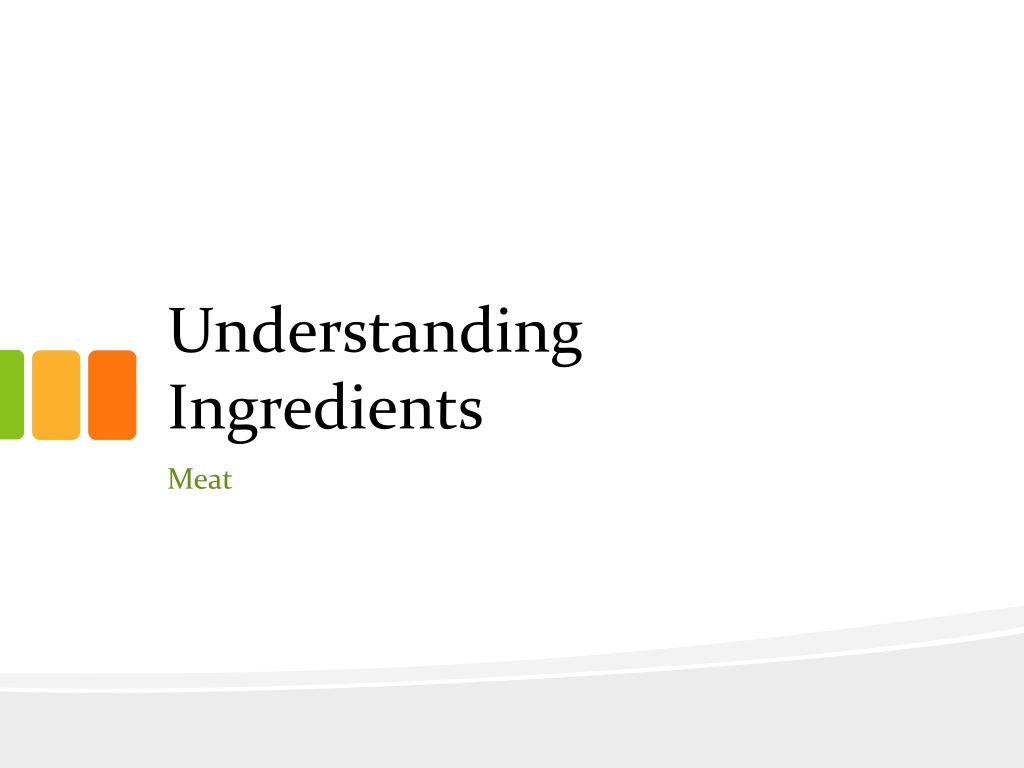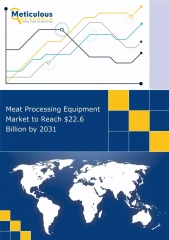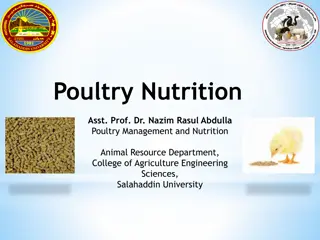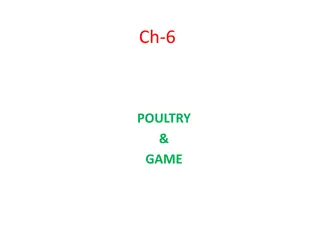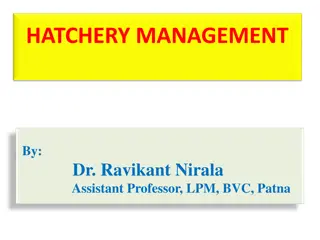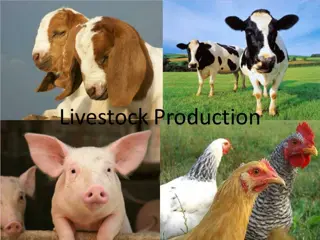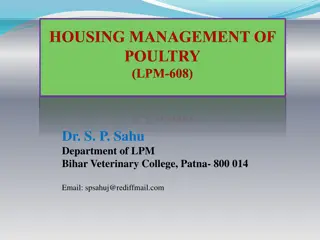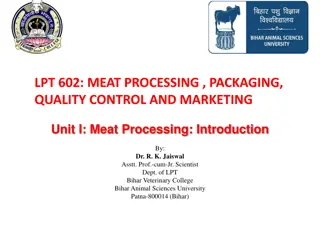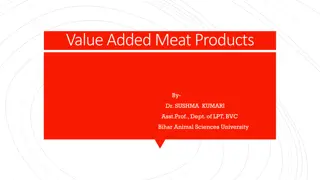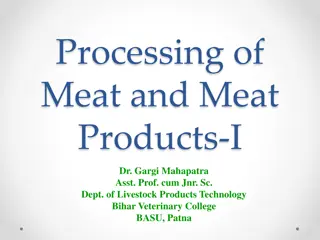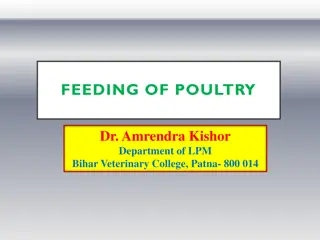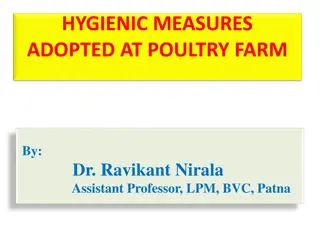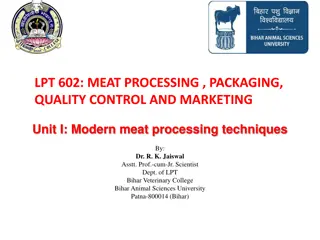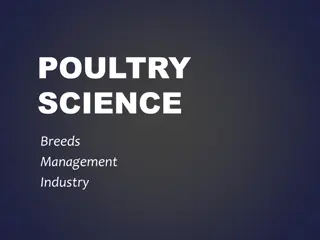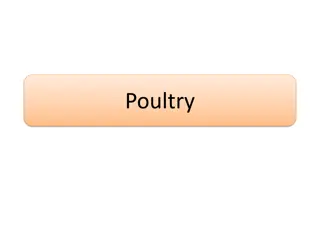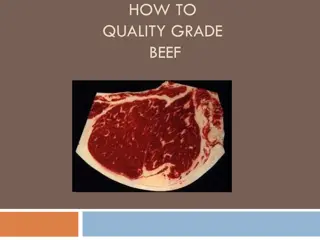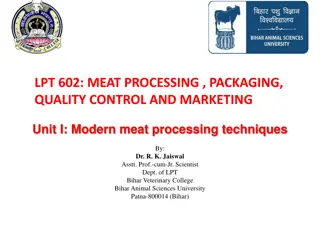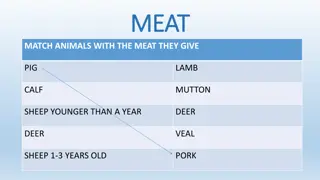Understanding Different Types of Meat and Poultry
This informative content delves into the world of meat and poultry, discussing various types, structures, nutritive value, and uses. From red and white meat to game animals, it covers the diversity of options available in markets and highlights processed products like canned meat and sausages. Learn about the differences between beef, chicken, lamb, and more as well as the composition of meat tissues. Discover insights on choosing, storing, and cooking meat effectively in your diet.
Download Presentation

Please find below an Image/Link to download the presentation.
The content on the website is provided AS IS for your information and personal use only. It may not be sold, licensed, or shared on other websites without obtaining consent from the author. Download presentation by click this link. If you encounter any issues during the download, it is possible that the publisher has removed the file from their server.
E N D
Presentation Transcript
Understanding Ingredients Meat
Topics Introduction Types of Meat and Poultry Structures of Meat and Poultry Nutritive Value of Meat and Poultry Choice and Storage of Meat and Poultry Uses of Meat and Poultry in Cooking / Diet 2
Introduction Meat may include the edible portion of mammals such as beef and pork, as well as the non-mammals poultry and fish. Meat is the edible portion the flesh of animals used for food Poultry are domesticated birds kept by humans for their eggs and their meat There is a variety of meat available in our shops and markets Red meat is the meat from mammals including beef and veal, lamb, mutton, and pork White meat refers to meat from poultry and seafood 4
Introduction Various animal flesh may be used as food throughout the world Game is meat from non-domesticated animals Examples of game are: rabbit, venison, pigeon, quail Meat are being sold fresh, chilled or frozen Meat is also processed or manufactured into meat products 5
Types of Meat and Poultry Fresh, chilled, or frozen meat available in Hong Kong Fresh, chilled, or frozen poultry available in Hong Kong Beef from cattle Chicken Lamb, mutton from sheep Duck Pork from pig Goose Veal from calf Pigeon Quail Turkey 7
Types of Meat and Poultry Processed meat and poultry products available in the market: Canned meat Corned beef Luncheon meat Canned sausages Smoked meat bacon Dried meat Chinese sausage Chinese preserved meat Jerky Cured meat Ham Frankfurters 8
Structures of Meat and Poultry 9
Structures of Meat and Poultry Meat is composed of three tissues: muscle tissue, connective tissue, and adipose or fatty tissue Muscle Tissue Muscle tissue is referred to as the lean tissue of meat It is made up of bundles of muscle fibres The muscle fibres are protein, they are hollow tubes which are filled with minerals such as iron and B vitamins 10
Structures of Meat and Poultry Connective tissue Connective tissue is made up of protein and mucopolysaccharides It is located throughout the muscle It determines the degree of meat tenderness, cuts that contains less connective tissue are more tender Connective tissue also extends beyond the muscle fibers to form tendons, which attach the muscle to bones Connective tissue also forms ligaments, attaching one bone to another 11
Structures of Meat and Poultry Connective tissue (cont d) Two important protein that forms the basic structure of connective tissue Collagen found in meat and poultry, the white connective tissue the structure is broken down by the application of heat, especially moist heat the greater the breakdown, the more tender the final product Elastin found in concentrated deposits appearing as a yellow, rubbery mass changed very little by cooking 12
Structures of Meat and Poultry The carcass is cut up and sold in smaller portions called joints or cuts Tenderness of meat cuts after cooking has a direct relationship to the amount and quality of connective tissue in the product Tender meat comes from young animals and birds, and the muscles which are not often used, e.g. along the back Tough meat comes from older animals and birds, and the well-used muscles such as the leg and neck Flesh from the breast and wing is easier to digest than that of the legs (drumstick) which is coarser and darker because of greater muscular activity 13
Cuts of Pork Tender cuts Tough cuts For frying, grilling, barbecuing, and roasting For stewing, boiling, slow cooking Loin Shin Fillet or tenderloin Belly Neck Foreleg Spare rib Head 14
Cuts of Beef Tough cuts Tender cuts Tender cuts For casserole, stewing, and slow cooking For grilling, frying, and barbecuing For roasting Topside of leg Rump Rump Flank Sirloin Shoulder Sirloin Tenderloin Brisket Ribs T-bone steaks Shin 15
Cuts of Lamb Tender cuts Tough cuts Tender cuts For grilling, frying, and barbecuing For casserole and stewing For roasting Neck Breast Leg Loin chops Shoulder Shoulder Scrag-end of neck Leg 16
Cuts of Chicken, Turkey, and Duck Tender cuts Tough cuts For frying, grilling, barbecuing, and roasting For stewing Breast Wing Fillet (boneless breast) Whole leg Foot Thigh 17
Structures of Meat and Poultry Tender cut (beef tenderloin) (left) and tough cut (beef brisket) (right) 18
Structures of Meat and Poultry Adipose or fatty tissue Adipose tissue: fat that is stored around the heart, kidney organs, and in the pelvic canal areas Subcutaneous fat: fat that is visible after the skin is removed, this layer of fat can be trimmed before cooking to reduce the fat content in a dish Intermuscular fat: fat between muscles Intramuscular fat: fat within muscles (marbling) 19
Structures of Meat and Poultry Adipose or fatty tissue (cont d) When cooked, the melted fat contributes to juiciness, the sensation of tenderness, and flavour Thus, well-marbled meat with intramuscular fat may be desirable (despite the high level of fatty tissues) 20
Structures of Meat and Poultry Intermuscular fat Intramuscular fat Well-marbled beef 21
Nutritive Value of Meat and Poultry 22
Nutritive Value of Meat and Poultry Meat and poultry are major sources of essential nutrients: Protein Meat provides high quality protein Fat Fat from meat contains a high proportion of saturated fatty acids, which can increase the cholesterol level in the blood and can increase the risk of coronary heart disease in some people Fat content can be affected by several factors: Type of meat pork has more fat than liver (liver has more cholesterol than pork) Parts eaten chicken with skin contains more fat than skinless chicken Method of cooking frying or deep-frying calls for more fat than roasting or grilling 23
Nutritive Value of Meat and Poultry Cholesterol Present in the cell membranes of all animal tissue Typically, lean meats have a lower cholesterol content than fatty meats, except for veal, which is low in fat, yet high in cholesterol Carbohydrates Negligible in animal tissue Small percentage of carbohydrates in animals is stored in the liver as glycogen 24
Nutritive Value of Meat and Poultry Vitamin A Vitamin A is only found in liver and kidneys, not in other parts meats Liver products such as p t are a useful source of Vitamin A Vitamin B Meat and poultry contain water-soluble B-complex vitamins that function as cofactors in many energy-yielding metabolic reactions 25
Nutritive Value of Meat and Poultry Iron Iron is found mainly in red meats and liver It is in soluble form which is easily absorbed and used in the body for the haemoglobin in red blood cells Chicken provides mainly white meat, therefore it contains little iron Zinc and phosphorus are present in meat, poultry contains little phosphorous 26
Choice and Storage of Meat and Poultry 27
Choosing Fresh/Chilled Meat and Poultry Fresh/chilled meat and poultry Fresh meat and poultry should be bright in colour Fresh pork is pale pink in colour and fresh beef is bright red Pork and beef should be firm, moist and springy to touch and with no unpleasant smell Poultry should be plump, with pliable breastbone 28
Choosing Frozen Meat and Poultry Frozen meat and poultry Should be in frozen state Should be no sign of thawing and re-freezing Check the expiry date Poultry should not have white patches on the skin 29
Storing Fresh/Chilled Meat and Poultry Raw meat and poultry should be stored in a sealed container or wrapped securely to prevent meat juices from contaminating other foods Storage Times for Refrigerated Foods Ground meat and poultry Ground beef, turkey, veal, pork, lamb 1-2 days Fresh meat (beef, veal, lamb, and pork) Steaks, chops, roasts 3-5 days Variety meats (Tongue, kidneys, liver, heart, chitterlings) 1-2 days Fresh poultry Chicken or turkey, whole 1-2 days Chicken or turkey, parts 1-2 days Giblets 1-2 days Source: Food Safety and Inspection Service, United States Department of Agriculture 30
Storing Frozen Meat and Poultry Keep frozen and store in a deep-freezer Before using, allow to thaw slowly overnight in the refrigerator Thaw completely before cooking Never refreeze thawed meat, harmful bacteria may have started to increase Never store cooked meat or ready-to-eat food together with raw meat. (The raw meat that carries bacteria may contaminate the cooked meat or ready-to-eat food) 31
Uses of Meat and Poultry in Cooking / Diet 32
Uses of Meat and Poultry in Cooking / Diet Appetiser/salad Roasted suckling pig Roast beef salad Shredded chicken with vermicelli Main dish Sweet and Sour Pork Beef Steak Chicken Curry Snack Ham and egg sandwich Beef curry samosa Chicken nuggets 33
References FSIS. Refrigeration and Food Safety, United States Department of Agriculture, 23 Mar. 2015. Provost, J., Kelly, B., Bodwin, J., & Wallert, M. (2016). The Science of Cooking. John Wiley & Sons. Vickie A. Vaclavik, Elizabeth W. Christian. Essentials of food science. New York, NY: Springer, c2008. 34
